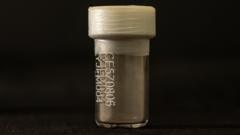The UK has welcomed its first samples of Moon rock in nearly five decades, transferred from China and secured in a high-security facility in Milton Keynes. This event, celebrated as a monumental scientific achievement, provides an exceptional opportunity for researchers to delve into lunar geology. Professor Mahesh Anand of the Open University is leading the research efforts as the sole UK scientist in possession of these Moon samples, which he considers "more precious than gold dust."
China’s Chang’e 5 mission successfully retrieved approximately 2kg of lunar material from a volcanic region known as Mons Rümker in 2020. For the first time, Chinese authorities have permitted international researchers to study these samples, with Anand obtaining a small yet precious 60mg for his research. Anand believes the grains may hold vital clues about how the Moon formed, potentially confirming theories about a massive collision between Earth and another planet 4.5 billion years ago.
Inside the Milton Keynes lab, strict protocols are observed to avoid contamination, including wearing gloves, gowns, and hair nets to maintain a pristine environment essential for accurate analysis. The samples are encapsulated in specially designed vials, with Anand emphasizing the importance of careful handling. As the initial technician to work with the dust, Kay Knight expressed her excitement and nerves over studying this extraordinary material, emphasizing the high stakes involved due to the limited quantity.
The research team plans to utilize advanced machinery to analyze the Moon dust further, including a unique device capable of heating the samples to extreme temperatures to extract essential elements, such as carbon, nitrogen, and noble gases. With a year to conduct their analysis, they are prepared for the possibility that their work may ultimately destroy the samples in the quest for knowledge.
Looking ahead, Professor Anand hopes this collaboration sets the stage for ongoing partnerships between China and international researchers, fostering a tradition of shared scientific exploration in the realm of lunar material studies. The Chang’e 6 mission, returning samples from the Moon’s far side in 2024, represents further significant steps in unraveling the mysteries of our celestial neighbor.





















